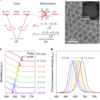Photonic circuits, which manipulate light to perform various computational tasks, have become essential tools for a range of advanced technologies—from quantum simulations to artificial intelligence. These circuits offer a promising way to process information with minimal energy loss, especially in fields like quantum computing where complex systems are simulated to test theories of quantum mechanics.
However, the growth in circuit size and complexity has historically led to a rise in optical losses, making it challenging to scale these systems for large-scale applications, such as multiphoton quantum experiments or all-optical AI systems.
As reported in Advanced Photonics, researchers at the University of Naples Federico II have now developed a new approach to address this problem. Using a liquid-crystal (LC)-based platform, the team designed an optical processor capable of handling hundreds of optical modes in a compact, two-dimensional setup. This breakthrough offers a solution to a key limitation in traditional photonic circuits, where losses increase as the number of modes grows.
The new system uses a set of three LC metasurfaces, precisely engineered to simulate quantum processes, such as the “quantum walk,” which is the quantum-mechanical analog of the classical random walk. This LC configuration allows the system to handle a large number of optical modes without a significant increase in losses, something that was previously difficult to achieve.
According to corresponding author Filippo Cardano, professor of physics at the University of Naples, “In theory, this circuit can handle as many modes as needed while maintaining constant optical losses, thus representing a significant breakthrough with respect to previous implementations.”

(a) A liquid-crystal metasurface (LCMS) acts as a patterned waveplate which modifies a controlled fraction of the beam transverse polarization profile by adding conjugate phases to the two circular polarization components. Based on this mechanism, a minimal set of three LCMSs can be adopted to simulate arbitrary unitary operations in a discrete two-dimensional space. (b) This space is populated by circularly polarized optical modes carrying a quantized amount of transverse momentum along two orthogonal directions, which can be resolved on a camera placed in the focal plane of a lens. (c) When computing the liquid-crystal patterns required for a specific simulation, the obtained solutions typically feature numerous discontinuous jumps. An automated routine is executed to remove all discontinuities except isolated vortices that can be tolerated in the fabricated devices. © Advanced Photonics (2025). DOI: 10.1117/1.AP.7.1.016006
In earlier experiments, Cardano’s team demonstrated the potential of this technology in one-dimensional setups, reaching record-breaking numbers of quantum walk steps. However, expanding this to two-dimensional systems presented new challenges, including the risk of disruptions in the liquid-crystal patterns that would affect light behavior.
To overcome this challenge, the researchers developed a new algorithm that creates smooth patterns, which incorporate isolated vortices that do not significantly impact light propagation. This innovation enabled the system to simulate up to 800 optical modes—much more than could be achieved with the one-dimensional approach.
Cardano notes that this technology is versatile and can be easily customized to suit a wide range of computational and simulation tasks, opening up new possibilities for low-loss circuits that could push the limits of photonic quantum experiments.
More information:
Maria Gorizia Ammendola et al, Large-scale free-space photonic circuits in two dimensions, Advanced Photonics (2025). DOI: 10.1117/1.AP.7.1.016006
Citation:
Liquid-crystal platform overcomes optical losses in photonic circuits (2025, March 27)


